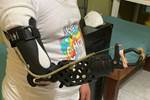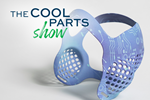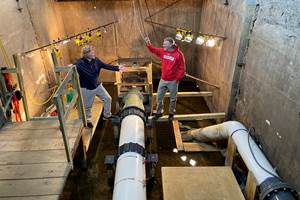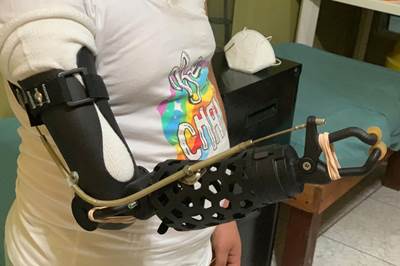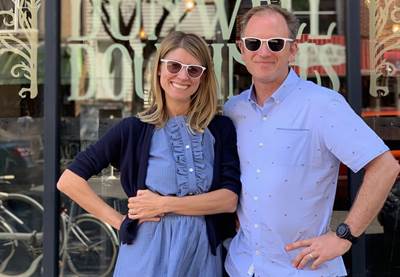Share
Conventional casts made by wrapping plaster or fiberglass around the patient’s body have been the standard of care for decades, but they can have significant drawbacks. For the patient, casts can be heavy, awkward and itchy. For the healthcare provider, they are time-consuming to create and can hinder patient care. Casting material can harbor moisture or bacteria, and hide infections or other skin conditions. And, casts often need to be cut off and replaced in the course of the healing process. ActivArmor offers an alternative that is durable, waterproof and contoured to the patient’s anatomy using data from a 3D scan. The 3D printed casts and splints make it possible to X-ray the injury without removal; easily monitor the skin; and even allow the patient to swim, exercise and bathe as usual. In this episode, we get a first-hand look at the 3D printed devices being used by NFL players, Olympians and regular people.| This episode of The Cool Parts Show brought to you by Carpenter Additive
The Cool Parts Show is a video series from Additive Manufacturing Media that explores the what, how and why of unusual 3D printed parts. Watch more here.
Have a cool part to share? Email us.
Related Resources
- More on how and why ActivArmor 3D prints these devices
- Another 3D printed device that helps its user stay active in sports
- Doctors are manufacturers in a sense, as we explore in this episode; so are dentists
- More custom products that start with a 3D scan: glasses frames, prostheses, shoe insoles
Transcript
00:00:00:05 - 00:00:00:16
Pete Zelinski
I'm Pete.
00:00:01:06 - 00:00:12:10
Stephanie Hendrixson
I'm Stephanie. And this is The Cool Parts Show. The show where typically we would bring you a story about an interesting, innovative 3D printed part. I'm not sure if that's going to happen this time because the two of us are kind of on the bench.
00:00:13:08 - 00:00:17:15
Pete Zelinski
But are we, though? I feel like we can keep going because of these 3D printed casts.
00:00:18:08 - 00:00:28:04
Stephanie Hendrixson
So we're not really injured. But even if we were, that is the advantage of these 3D printed casts. The ability to keep doing your normal activities even while you're recovering from an injury.
00:00:28:19 - 00:00:38:17
Pete Zelinski
Additive manufacturing for casts on this episode of The Cool Parts Show.
00:00:38:17 - 00:00:52:05
Stephanie Hendrixson
This episode of The Cool Parts Show is brought to you by Carpenter Additive. The company's PowderLife solution is a combination of hardware and software technologies designed to help AM users manage their metal powders. Stay tuned after the episode for more on how the system works.
00:00:52:21 - 00:00:54:04
Pete Zelinski
Welcome to The Cool Parts Show.
00:00:54:15 - 00:01:03:21
Stephanie Hendrixson
Thank you for joining us. If you like what you see, give us a like hit that subscribe button. Today we're going to be talking about 3D printed immobilization devices, things like splints and casts.
00:01:04:12 - 00:01:30:15
Pete Zelinski
Yeah, we do episodes of the show. We have cool parts, and a lot of times we have to explain the coolness. How does this part help a valve? How does this part help a circuit breaker? But with this, I think anybody who's ever broken a bone can appreciate how this is a better solution. This removable cleanable cast. And look, you can even - like you can scratch an inch just like that.
00:01:31:01 - 00:01:58:09
Stephanie Hendrixson
Yeah. So compared to a conventional cast that's going to be made out of, like, fiberglass or plaster wrapped around your body, this is a lot more comfortable to wear. It's lighter weight. You're not going to get, you know, sweat and bacteria and stuff building up underneath. So these 3D printed casts are a new way of doing things like supporting a broken bone, helping a sprain, assisting with things like carpal tunnel syndrome. A whole range of different injuries and conditions can be helped with these casts.
00:01:58:20 - 00:02:23:14
Pete Zelinski
So these casts were made by ActivArmor. Each cast is customized to the patient based on a scan of the patient's extremity. So my cast is based on a scan of my arm. Stephanie's was based on a scan of hers. And this whole system is the brainchild of ActivArmor founder Diana Hall, who had some kind of heart rending experiences with conventional casts.
00:02:24:03 - 00:02:34:23
Stephanie Hendrixson
Yeah. So Diana is a chemical engineer with a background in software and process engineering, but she first started thinking about casts while she was running a mentorship program for underprivileged kids.
00:02:35:17 - 00:03:49:07
Diana Hall
I saw a lot of kids that had to wear casts that were fiberglass and they would get them through Medicaid. They would have domestic violence, substandard living conditions. So they would often be wearing these casts and they would just get them filthy, just couldn't even practice basic hygiene, like washing your hands to have a snack. And one little girl had bedbugs under hers. She was sleeping on her grandparents floor. And one little boy had elderly and disabled grandparents and he couldn't keep his dry in a bag outside the shower by himself. And he got it wet. And he wore it like that for three weeks and ended up with permanent scarring on his arm due to the skin breakdown. So when I saw that, I knew that there was a solution in 3D printed plastics that could be customizable.
So I 3D printed out of ABS plastic, the same plastic as Legos, a little cast that was fitted for the kids. And I said, Take this to your doctor and ask them if you can wear this instead, just so you can play on the playground, get dirty, you know, take a shower, just do your normal lifestyle activities. The doctor called me a few days later and said, Can you make me some more of these?
00:03:50:02 - 00:04:12:07
Pete Zelinski
So there was this idea. 3D printing to tailor make cleanable removable casts for individual patients. What followed was a question, Is this okay? Is it all right for 3D printed plastic to be a cast material? Diana Hall is not a doctor, so she set about finding the answer to that question.
00:04:12:22 - 00:05:03:22
Diana Hall
So I called the FDA and I said, Can I do this? And I got connected with Dr. Lex Schultheis at the University of Maryland, Fischell Institute for Biomedical Devices, who is a consultant for the FDA to develop the test protocols for 3D printed wearables. And I worked with him to help test ActivArmor products, and I published research abstracts in collaboration with the University of Maryland and the FDA on testing for things that you would have to consider for medical device wearables, including micro porosity, so it doesn't trap moisture and bacteria against the skin, biocompatibility so it doesn't react with the skin. All the things that you would need to make sure that these products are safe and effective as well as customized fitted to every patient.
00:05:04:15 - 00:05:15:03
Stephanie Hendrixson
So let's pause for a second and talk about those conventional casts because obviously the wrapped plaster or fiberglass that is custom made to the patient as well, it's just being done in a very manual process.
00:05:15:20 - 00:05:25:16
Pete Zelinski
Yeah, we've talked about mass customization on The Cool Parts Show before, but your doctor's office has been doing mass customization for a long time.
00:05:26:04 - 00:05:54:10
Stephanie Hendrixson
Right? But there's a lot of room for error in that traditional casting process. Your cast might end up being too tight or too loose. Maybe your limb isn't in exactly the right position. And so healing becomes uncomfortable or in the worst case scenario, maybe your injury even heals improperly because of the way that the cast was made. And so ActivArmor is customized as well, but it's in a much more automated process, which is something we've got firsthand experience with.
00:05:54:21 - 00:06:23:06
Pete Zelinski
The customization, that's a strength of 3D printing, but in this case, the customization is not the bonus or the special feature that additive manufacturing brings. The customization is a requirement. A cast doesn't work if it's not customized, and 3D printing is a manufacturing method that is able to produce a customized, a tailor made component. And we did experience that. So talk about that. How does ActivArmor get there?
00:06:23:17 - 00:06:54:08
Stephanie Hendrixson
Yeah. So as you said, everything starts with the scan. In the beginning, ActivArmor was using like a handheld 3D scanner. Unfortunately, those aren't super affordable or accessible, so they have since developed a free smartphone app that can do the scan as well. So the process now looks more like you go in for an injury and your doctor or maybe a casting technician would position your limb in the right place, draw some markings to show where the device needs to go, do the scan, take some measurements and share that with ActivArmor to get the process rolling.
00:06:54:19 - 00:07:56:08
Diana Hall
So the process for receiving your ActivArmor cast is that you use a free iPhone app. It's a digital 3D scanning app that we have developed. And you do a one minute scan of whatever body part. It's a full color scan, so you can draw right onto the skin where you want the cut lines to be. If there's a bony protrusion or an incision that you want offset or you want an exposure for a bone stimulator or anything custom. That design then goes into our automated design software. That is a graphical user interface on the cloud that you can then apply those custom designs and you can put it right on the marks that you made on the scan and develop your custom design and it'll visualize it for you. And then you can export the design file to be printable on any printer, or you can have it export in G code that can be fed directly into our printer with a turnkey process that we have.
00:07:56:18 - 00:08:55:07
Stephanie Hendrixson
So there are a couple of different ways that these devices are getting made ActivArmor still prints quite a few of them. They use modified Fusion 3 EDGE printers. So Fused Filament Fabrication, FFF. These are like extrusion style desktop 3D printers and they produce them out of their office in Colorado. They also have production partners around the country, actually around the world.
And even though this solution was developed with FFF in mind and ABS material, Diana says that ActivArmor can be printed on a number of different types of platforms, different technologies, including things like multijet fusion, selective laser sintering and other materials as well. The ones that we have here in the studio with us were made by ActivArmor with that FFF process.
They're made out of ABS and it takes about two, two and a half hours for them to print a device this size. For the first version, these are pretty much ready to go out of the printer. There are no support structures, really minimal post-processing, maybe just a little bit of sanding and attaching these bungee closures.
00:08:56:08 - 00:09:28:18
Pete Zelinski
This idea is out there. Thousands of patients have been healed using casts like this. The number of prescribing physicians at last count is about 100 and climbing. And they're learning some things. ActivArmor knows, for example, that this is a really good solution for children. Do you know who else this is a good idea for? Professional athletes, professional football players. Here is Jacksonville Jaguars team physician Dr. Kevin Kaplan.
00:09:29:11 - 00:10:44:23
Dr. Kevin Kaplan
So I'm Dr. Kevin Kaplan. I'm an orthopedic surgeon with a specialty in sports medicine, and I'm the head team physician for the Jacksonville Jaguars. The NFL and football is a contact - It's a high velocity contact sport. So we see injuries all over the body. I operate mostly on shoulders, knees and elbows. But we see injuries throughout the body.
And I'd say that the more common injuries we see are in the distal extremities, meaning hands, wrists, elbows, and then lower extremity injuries like ankle sprains and foot injuries as well. Casts are a part of the game in order to allow players to continue to play when they have certain injuries. Obviously, not every injury is something you can play with, but some of the injuries we see, you could potentially play with as long as it's protected.
And the old school casting, which has been around for a while, is cumbersome, number one. Number two adds the human element, whether or not it fits exactly right and whether or not a player will actually feel comfortable playing in it. And so when one of our players in the past a defensive lineman had a wrist injury, I was looking for a better solution rather than the athletic trainer having to make a splint or a cast every practice and then take it off and then put it back on for games. Obviously, you're making and taking off a lot of splints and casts.
00:10:45:13 - 00:11:09:23
Stephanie Hendrixson
So Dr. Kaplan was looking for a way to make casts that would be reusable so the team wouldn't have to keep remaking these devices before every practice, before every game. And so ActivArmor offers that and you can take them off with them on. They are reusable, they are removable. They also have the added benefit of being really durable.
So this would allow players to continue to play and practice to the best of their abilities while they're still healing from an injury.
00:11:10:05 - 00:11:24:18
Dr. Kevin Kaplan
In the NFL it's all about being available and it's a very much week to week type of job. So to be able to get that, turn around and get it on the athlete as quick as possible to allow them to be out there safely is best for us and best for the team.
00:11:25:05 - 00:11:41:14
Pete Zelinski
Best for the team, best for the football players. But good for other population groups too. Dr. Kaplan had more to say about the virtues of 3D printed casts that he sees for the kind of patients he works with outside of the NFL season.
00:11:42:05 - 00:12:31:09
Dr. Kevin Kaplan
You know, as kids, we all run around and get dirty and get filthy. And I've seen plenty of casts come in that were absolutely filthy, you know, And so having something that you can clean and wash and is not going to lose its shape is certainly ideal. But then you look at the older population or even a diabetic population where skin is an issue.
This allows us to stay vigilant with our patients wounds and skin. And there's been, you know, a number of articles written in our orthopedic literature about the dangers of casting. I mean, casting is not without risk. You can get pressure sores, you can get ulcers, you can get skin infections and cellulitis, which is an infection, inflammation of the skin.
These are all real things that can be potentially very big problems. And so this cast solves a lot of those issues by being open and being able to be cleaned on a regular basis.
00:12:32:04 - 00:13:11:02
Stephanie Hendrixson
So as we said, ActivArmor is out there now. It's treated like a regular splint by insurance companies. These are being used by NFL players, by Olympic teams, by the military, as well as by kids and just regular people. But the next step is to make ActivArmor even more accessible than it already is. So the company is working on a turnkey solution that includes the ActivArmor software and one of the 3D printers that they use that can go into a doctor's office or another clinical setting.
This is point of care 3D printing. It would allow health care professionals to diagnose a patient, do a scan and 3D print these devices right there in the clinic. This is actually something that Doctor Kaplan's practice is looking at.
00:13:11:15 - 00:13:43:18
Dr. Kevin Kaplan
I think having a printer in our office even enhances the ability for us to use this and makes it easier for patients. Certainly if they can come in point of care, get diagnosed, get scanned, print it right there and put the cast on. That would obviously make this the gold standard. And I think most patients, given the choice, would want something that fits them perfectly that they can use and wear any time of day in the shower and in the pool. So I think having that in our office would be game changing.
00:13:44:09 - 00:13:57:20
Pete Zelinski
Other next steps. It's worth saying, this isn't just 3D printing. There's data here too. A lot of data, and that data could be used. Potentially this system could get smarter.
00:13:57:20 - 00:14:13:06
Stephanie Hendrixson
So if every device starts with a scan, you can tie that information back to the patient's condition and then tie it to their ultimate health outcomes. And if you do that enough times, you can start to learn things about how particular designs and particular devices can help with healing certain injuries.
00:14:13:18 - 00:14:53:02
Diana Hall
So our plan is to integrate the AI function in 2024. We're already collecting data. We already have thousands of scans and they're correlated to diagnoses. So if you have a buckle fracture - a pediatric buckle fracture in your wrist, here's a scan showing the size of the patient. The position that the physician put them in for the scan and the device that they order for them.
And all of that data can be collected in order to feed and fuel algorithms that can help support consistent treatment options and the best treatment options.
00:14:53:11 - 00:14:54:17
Pete Zelinski
All right, Let's wrap this up.
00:14:55:13 - 00:15:22:05
Stephanie Hendrixson
All right. These are 3D printed casts produced by ActivArmor. The ones that we have here were produced through fused filament fabrication out of ABS, although they could be made out of other materials using other processes. Each device starts with a scan of the patient's limb using a smartphone app. There are design tweaks that can happen in software and then the company will produce them themselves at their facility in Colorado or through a number of different production partners around the world.
And ActivArmor is working on making the solution even more accessible. They're developing a turnkey package that will allow doctors to be able to print these devices right there in their practice.
00:15:32:21 - 00:16:00:12
Pete Zelinski
This design solves a lot of the problems of conventional casts. Conventional casts are hard to clean. They get dirty, they are uncomfortable to wear. They are not reusable. They make it hard for you to do your normal life. This cast, it comes on and off easily. It is cleanable. It is adjustable. This is quite possibly the future of how casts will be produced.
00:16:01:06 - 00:16:20:03
Diana Hall
The word of mouth is spreading, and when patients wear a device like this out in their community, you wouldn't believe the number of calls that we get. It averages 5 to 20 new patient referrals for every one patient wearing one. It works. It's not a novelty, you know, 3D printed toy or whatever. This can be a standard of care.
00:16:20:12 - 00:16:32:00
Dr. Kevin Kaplan
Casting is one of those things that hasn't been changed in years. And I think this is kind of the first new innovation and I really think it's going to take hold and you're going to see a lot more of this type of device being used in the community.
00:16:32:15 - 00:16:37:15
Pete Zelinski
That's it for this episode. If you like the show, leave us a comment to let us know and be sure to subscribe.
00:16:38:00 - 00:16:47:00
Stephanie Hendrixson
And if you have a cool part that's changing how something has been made for decades or centuries, we want to hear about it. Email us at cool parts additive Manufacturing dot Media.
00:16:47:04 - 00:16:48:01
Pete Zelinski
Thank you for watching.
00:16:48:11 - 00:17:15:12
Stephanie Hendrixson
Thanks again to our sponsor Carpenter Additive. In addition to supplying metal powders, the company also offers services, software and hardware to help AM users manage their powder. One example is the PowderLife System, a combination of cloud based tracking software with hardware designed to make powder handling easier. Two key components are the PowderLife Hopper and the automated docking station.
Luke Boyer, manager of PowderLife Applications and Andrew Holliday, Applications Engineer, explains how the system works.
00:17:15:22 - 00:17:44:23
Luke Boyer
So today, when a user of additive manufacturing is receiving powder, they oftentimes receive it in either five, ten, 15, maybe a 20 kilo bottle, but they're receiving pallets of them and they’re receiving ten, 20, 50, 100s of these bottles. The user has to look and segregate and store them appropriately. So the bottles don't get mixed up and it requires a lot of lifting and moving labor.
00:17:45:06 - 00:18:18:18
Andrew Holliday
The components of PowderLife are all based around making powder management systems on the additive manufacturing shop floor easier to use for the operator cleaner as well as more traceable. Three of those basic parts of PowderLife are PowderLife Hoppers or our storage containers for powder. The second would be automated docking systems that allow material to be pushed in and out of machines with no human contact. The third would be our PodwerLife Online software system that allows you to trace this powder as it goes through your shop floor.
00:18:18:18 - 00:18:49:10
Luke Boyer
The hardware and the software together just helps really streamline that and improve the final user's experience and let them concentrate on going from design to the part itself. Takes the headache of powder management out of the equation for them.
Related Content
How Large-Format 3D Printing Supports Micro-Scale Hydropower
There is potential hydroelectric power that has never been unlocked because of the difficulty in capturing it. At Cadens, additive manufacturing is the key to customizing micro-scale water turbine systems to generate electricity from smaller dams and waterways.
Read MoreThis Drone Bird with 3D Printed Parts Mimics a Peregrine Falcon: The Cool Parts Show #66
The Drone Bird Company has developed aircraft that mimic birds of prey to scare off problem birds. The drones feature 3D printed fuselages made by Parts on Demand from ALM materials.
Read More3D Printing with Plastic Pellets – What You Need to Know
A few 3D printers today are capable of working directly with resin pellets for feedstock. That brings extreme flexibility in material options, but also requires greater knowledge of how to best process any given resin. Here’s how FGF machine maker JuggerBot 3D addresses both the printing technology and the process know-how.
Read MoreSolving 3D Printing’s Hidden Problem: Vibration
Ulendo’s vibration compensation software can double the speed of FFF 3D printers while maintaining part quality, all without changing the machine’s hardware.
Read MoreRead Next
How A Digital Manufacturing Workflow Is Making Orthoses, Prostheses More Accessible
Digitization of the workflow needed to create limb prostheses, orthoses, helmets and more means that these devices will become more readily available. Using 3D scanning and 3D printing, EastPoint Prosthetics and Orthotics and Additive America have established a way to produce these devices that both changes lives and makes business sense.
Read More3D Printed Headgear that Can Take a Hit: The Cool Parts Show #31
A custom helmet made via Multi Jet Fusion has allowed Sarah Piersanti to get back to practicing jiu-jitsu without fear of damaging her cochlear implant.
Read MoreFitz Frames Brings Mass Customization to Eyewear with Affordable 3D Printed Glasses Frames
Glasses don’t need to be ill-fitting and frustrating to buy. Fitz Frames offers a different kind of shopping experience (using augmented reality and 3D measurement) to produce custom glasses with 3D printed frames that are affordable, durable, comfortable and stylish.
Read More

.jpg;width=70;height=70;mode=crop)
